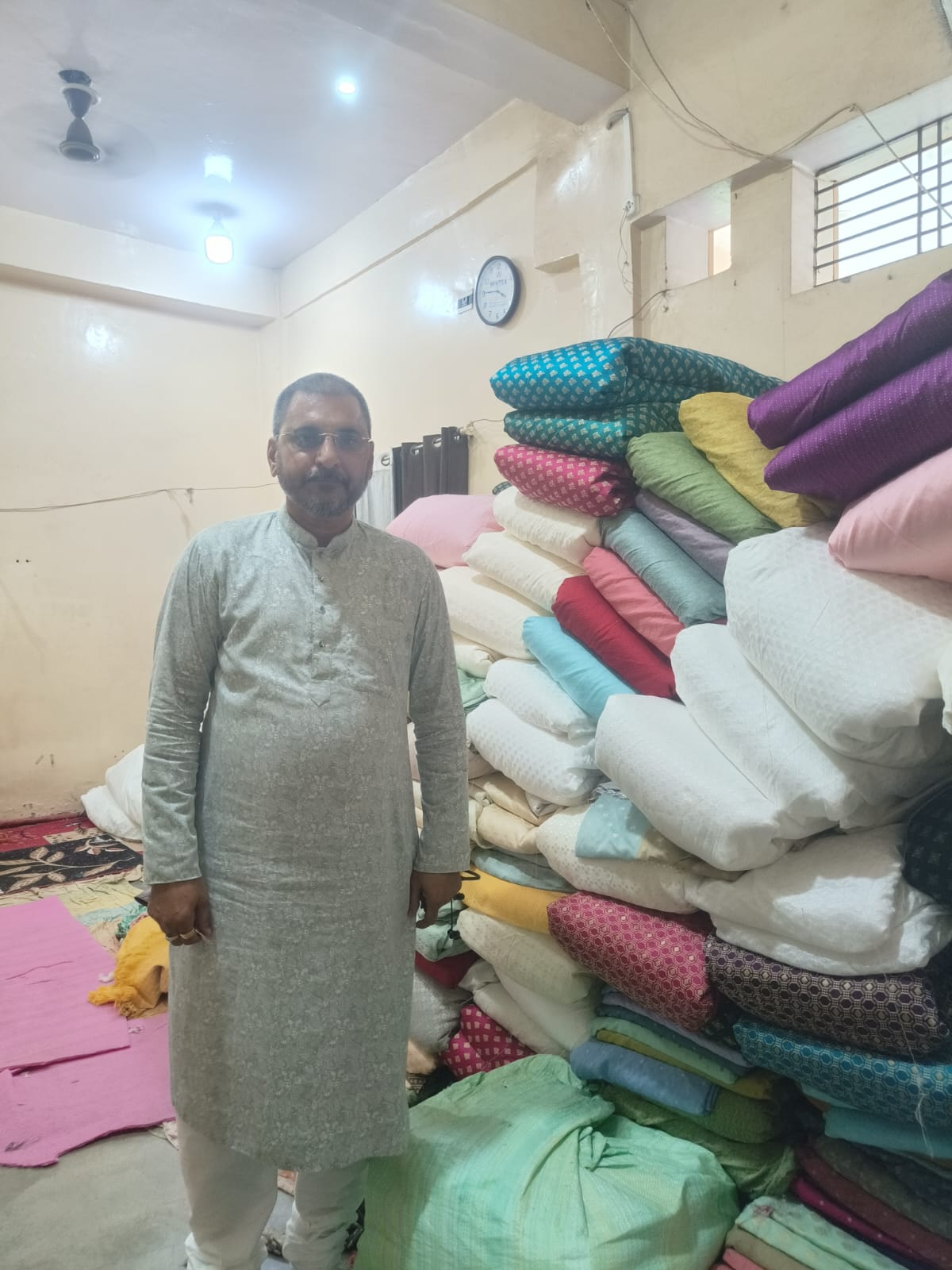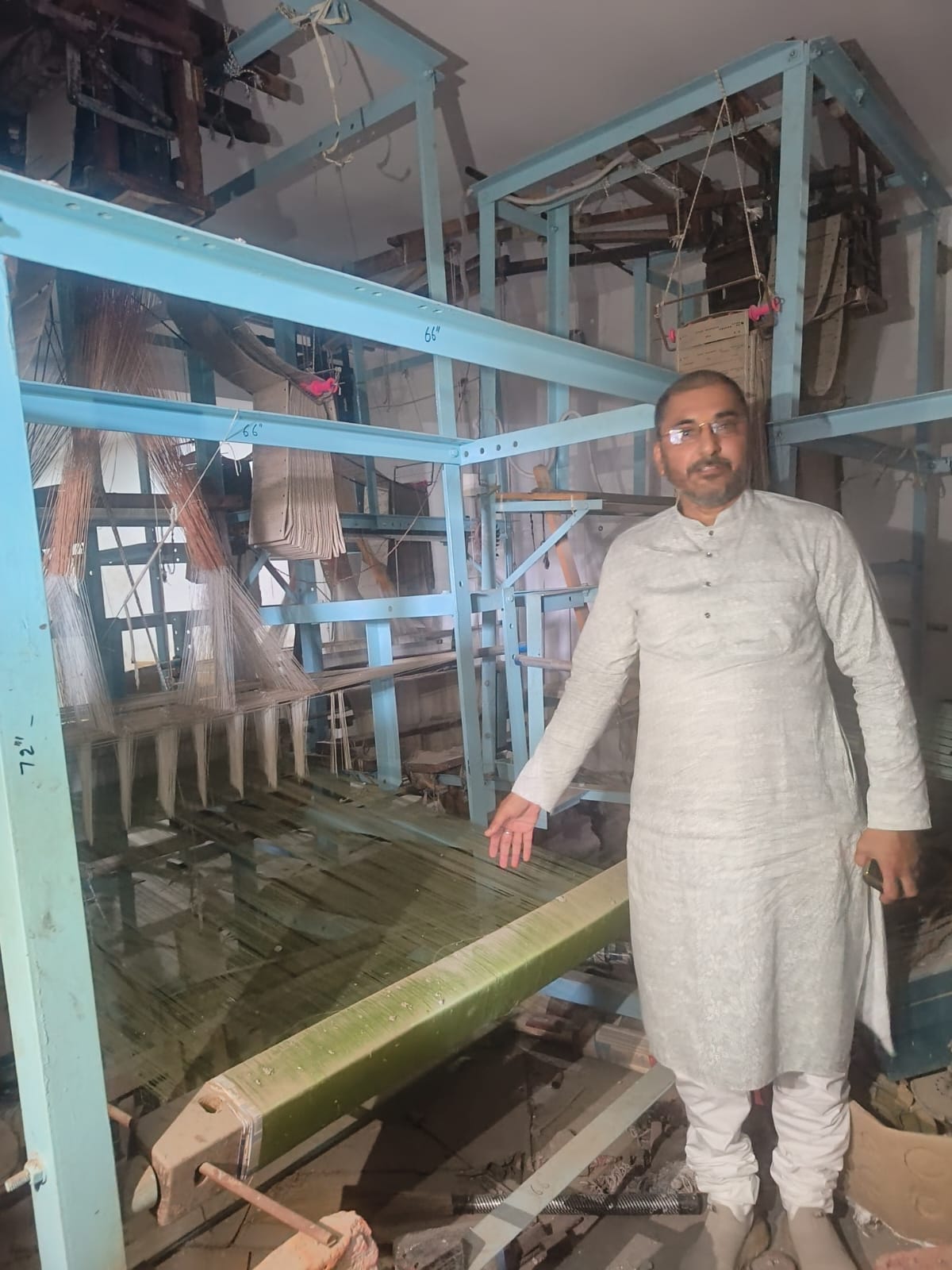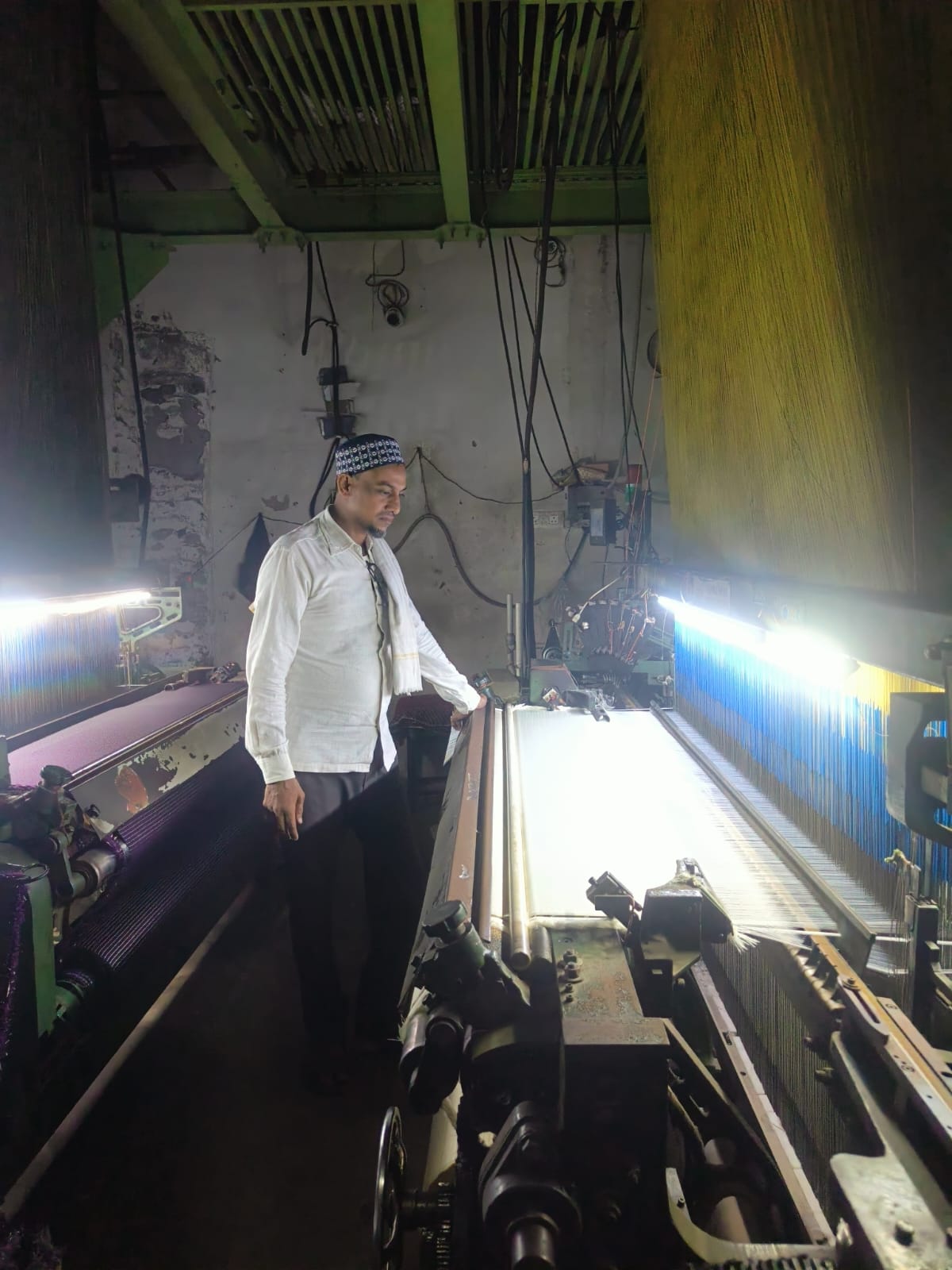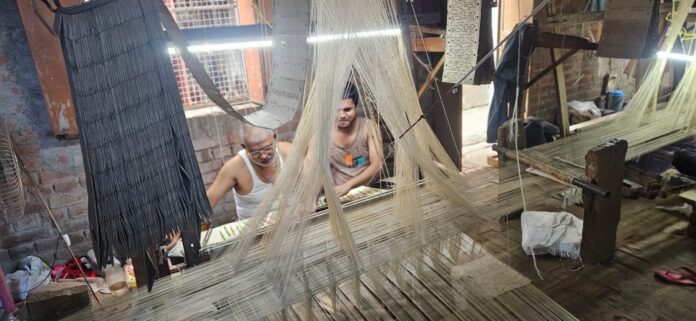Aradhana Pandey, TwoCircles.net
Varanasi (Uttar Pradesh): The city of Varanasi, once the shimmering epicentre of India’s silk legacy, now finds its Banarasi saree industry in deep distress. With the United States (its largest premium silk market) imposing a steep 50% tariff on Indian textile imports, the fate of nearly 8 lakh artisans, traders and workers hangs precariously in the balance.
From the bustling power looms of Lohta to the meditative handlooms of Madanpura, the rhythm of weaving that once echoed through narrow alleys is fading. Orders have begun to vanish. Stockpiles of unsold sarees weigh heavy not just on warehouse shelves, but on the hearts of those whose lives are tied to every thread. To the weavers, in addition to being a commercial crisis, it is a deep rupture in the cultural and economic soul of Varanasi.

Shailesh Singh, state head of the Weavers’ Cell at Sahkar Bharati, captures the scale of the decay, “There are around 1 lakh powerlooms in Varanasi, but due to flawed government policies, only 25,000 are functional today. The rest have gone silent.”
Those remaining looms still manage to produce between 25,000 and 30,000, worth approximately Rs 2 crore, sarees daily. Monthly, this amounts to Rs 50 crore. Meanwhile, 8,000 handloom units, far fewer but deeply revered, generate handwoven sarees worth Rs 15 crore each month. Together, the Banarasi saree industry stands at an estimated annual turnover of Rs 600 crore.
Beyond Varanasi, similar Banarasi-style sarees are crafted in Mubarakpur (Azamgarh) and Mau. But wherever the loom may hum, the shadow of the U.S. tariff is long, particularly for the handloom sector, which now faces an increasingly uncertain tomorrow.

In his Lohta workshop filled with 25 powerlooms, Kausar Ansari expresses what so many silently carry, “Thirty-six percent of all Banarasi sarees are exported to America. This is not merely a number. It is thousands of families’ livelihoods. With a 50% tariff, the premium segment of pure silk sarees has come to a standstill. Orders worth crores are on hold, and warehouses are packed with unsold stock,” he says.
Amresh Kushwaha, owner of the Angika Saree in Rambag, sheds light on the urgency. “We had just started recovering after COVID-19. Earlier, we sold 90 out of every 100 sarees we produced. Now, we feel lucky if we manage to sell 10. Big buyers are holding off orders after the US tariff. Crores are stuck in the handmade luxury segment. The United States is our largest market, followed by Europe and the Gulf. When the biggest market falters, the whole chain collapses,” he says.
Broken Supply Chains, Disrupted Ecosystems
The tariff’s impact is felt far beyond direct U.S. shipments. Countries such as Japan, Bangladesh, Vietnam and Indonesia previously imported Banarasi textiles for “third-party re-export” to the United States. This model generated consistent demand for Indian artisans. Now, with the U.S. extending tariff coverage to these nations, that vital channel has all but shut down.
A silent disquiet lingers in the by lanes of Varanasi. The promise once kindled by slogans like ‘Make in India’ and ‘Vocal for Local’ has dimmed under the weight of shifting global trade dynamics. The heartbeats of looms that once sang the city’s story now stutter with uncertainty.

Ancestral Craft in Crisis
In Bhatti village, Rishabh Singh once ran a thriving unit with a flourishing handloom section. Today, those handlooms – symbols of India’s intricate artistry – stand motionless.
“Our strength lies in customisation – design, threads, fabrics and sizing, all according to client requirements. All we ask is a small tax relief on textiles, so we can better cope with US tariffs. After agriculture, weaving is India’s largest source of livelihood,” he says.
Lives Entangled in Threads
More than 8 lakh people form the living organism that is the Banarasi weaving industry (weavers, traders, tea vendors, barbers, auto drivers and countless others). Their lives are linked to the rise and fall of every saree sold. That delicate balance is now breaking. Wages have declined. Migration is rising. The weaving capital is bleeding skills and stories, one artisan at a time.

Born into a family of traditional weavers, Ashfaq Ahmad describes, “Earlier, we had work every day of the month. Now it is just three to four days a week. Incomes have stagnated at Rs 9,000-Rs 10,000 a month. How can one manage school fees, medical expenses and groceries with that? Every house in our lane once had a loom. Children’s laughter and the hum of work created a vibrant scene. Now, there is silence. It is as if someone has muted the heartbeat of the city.”
Sarwar Ali’s words reflect a similar ache:
“We do not get timely wages. What we do get does not keep up with inflation. My two brothers have had to leave for Surat, where they work in dyeing and packing units. Our neighbourhood feels deserted. Even those who worked daily on looms are moving to the Gujarat city, where work is guaranteed. The cheaper and machine-made sarees from there are flooding the market, hitting Banarasi saree sales hard.”
The pandemic already bruised the industry. Weddings and festivals, the season of saree sales, were postponed or cancelled. Just as hope was beginning to return, the tariff crushed it once again. Buyers in the United States are now turning to alternatives from China, Vietnam and Bangladesh (often cheaper and delivered faster).

The Weight of Debt
Weaving in Varanasi is not only an act of creation. It is a daily negotiation with debt, displacement and delayed dreams. Every weaver knows the word “baaqi”, outstanding dues that cling to their ledger like shadows.
“When a weaver starts weaving on ‘taani’ (piece-rate basis) or ‘mazdoori’ (daily wages), he borrows from the ‘girasta’ (trader). Whether for weddings, school fees or medical needs, the debt grows. Sometimes, one has to take a loan from another girasta just to pay the first. Traders change, but the burden of debt stays,” explains Ashfaq.
The burden often becomes too heavy. Families, some tied to this craft for generations, are migrating to Surat, Mumbai, Ludhiana and taking up jobs in dyeing, packaging or running machines. They leave behind the scent of silk, the whisper of looms and a city slowly forgetting how to weave its own magic.
Fading Identity, Vanishing Heritage
In Bajardeeha, master weaver Athar Jamal Lari speaks of what is slipping away, “Weavers have no work, and traders have no customers. Even tourists have dropped, and those who come, barely 10% of them buy sarees. The business is deteriorating fast. Migration is increasing as the younger generation does not want to carry the legacy ahead. The identity and quality of handloom sarees far exceed power loom products, but youth are drawn to quick money and low effort. This has pushed authentic Banarasi handloom sarees to the brink of extinction.”
He adds that despite the Geographical Indication (GI) tag, sarees made elsewhere are now sold under the Banarasi label, eroding trust in genuine craftsmanship. The U.S. tariff only intensifies this erosion, pushing the industry deeper into distress.
A Call to Save Banaras’s Soul
Among those still holding the fort, there is clarity about what must be done. Weavers across Varanasi stress that saving this industry demands not just attention but urgent and coordinated action. This is more than economics. This is about preserving a centuries-old heritage that tells the story of India’s soul.
Idrees Ansari, a weaver leader, articulates this vision, “The US tariffs have made one thing clear: over-reliance on a single major market is risky. The government and exporters must pursue new trade agreements and promotional campaigns in markets across Europe, the Gulf, Africa and Southeast Asia. Free Trade Agreements (FTAs) can help expand the reach of Banarasi sarees in small and mid-sized markets. Indian embassies and trade missions should actively promote Banarasi silk abroad.”

Alam Ansari, a weaver from Lohta, outlines the way forward, “If the Banarasi saree industry is to be saved, weavers need access to low-interest loans, electricity subsidies and tax relief on raw materials. A ‘Heritage Production Incentive’ should be introduced for handloom weaving so that the younger generation is encouraged to return to the craft. Exporters should receive financial support to participate in international fairs and exhibitions. The GI tag will only be truly effective if there is strict enforcement against counterfeit Banarasi sarees, along with a digital certification system for authentic Banarasi products.”


